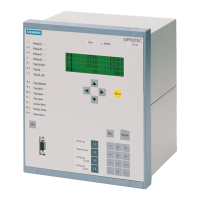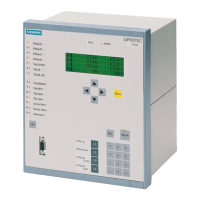Functions
2.19 Impedance Protection (ANSI 21)
SIPROTEC, 7UM62, Manual
C53000-G1176-C149-7, Release date 03.2010
152
2.19 Impedance Protection (ANSI 21)
Machine impedance protection is used as a selective time graded protection to provide the shortest possible
tripping times for short-circuits in the synchronous machine, on the terminal leads as well as in the unit trans-
former. It thus also provides backup protection functions to the main protection of a power plant or protection
equipment connected in series like generator, transformer differential and system protection devices.
The impedance protection function of 7UM62 always operates with the currents of side 2 (I
L1, 2 ,3; S2
).
2.19.1 Functional Description
PICKUP
Pickup is required to detect a faulty condition in the power system and to initiate all the necessary procedures
for selective clarification of the fault:
• Start the time delays for the final stage t3,
• Determination of the faulty measuring loop,
• Enabling of impedance calculation,
• Enabling of tripping command,
• Indication/output of the faulty conductor(s).
Pickup is implemented as overcurrent pickup and can be optionally supplemented by an undervoltage seal-in
circuit. After numeric filtering, the currents are monitored for over-shooting of a set value. A signal is output for
each phase where the set threshold has been exceeded. These pickup signals are considered for choosing the
measured values. The pickup is reset when 95% of the pick-up threshold is undershot, unless maintained by
the undervoltage seal-in feature.
Undervoltage Seal-In
With excitation systems powered from the network, excitation voltage can drop during a local short circuit, re-
sulting in decreasing short-circuit current which, in spite of the remaining fault, can undershoot the pickup value.
In such cases the impedance protection pick-up is maintained for a sufficiently long period by means of an un-
dervoltage controlled seal-in circuit using the positive sequence voltage U
1
. Pickup drops off when this holding
time has expired or when the restored voltage reaches 105% of the set undervoltage seal-in value.
The seal-in logic operates separate for each phase. The first pickup starts the timer T-SEAL-IN.
Figure 2-61 shows the logic diagram of the pickup stage of the impedance protection.
Determination of the Short–Circuit Impedance
For calculating impedance only the currents and voltages of the faulty (shorted) phase loop are decisive. Ac-
cordingly the protection, controlled by the pickup, evaluates these measurement values (see also Table 2-9).

